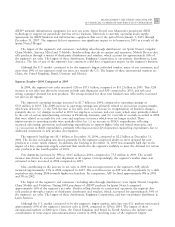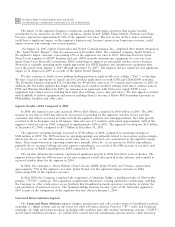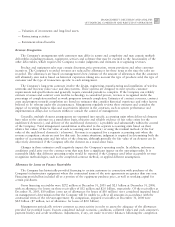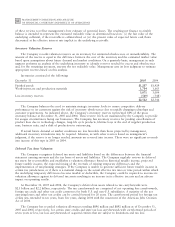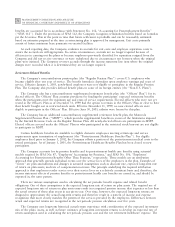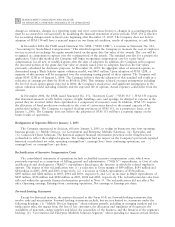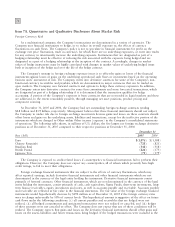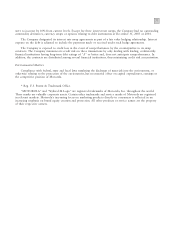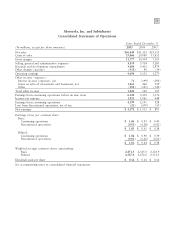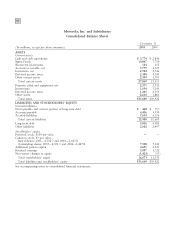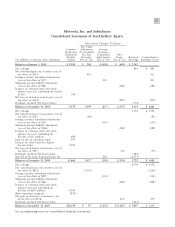Motorola 2005 Annual Report Download - page 78
Download and view the complete annual report
Please find page 78 of the 2005 Motorola annual report below. You can navigate through the pages in the report by either clicking on the pages listed below, or by using the keyword search tool below to find specific information within the annual report.
71
MANAGEMENT'S DISCUSSION AND ANALYSIS
OF FINANCIAL CONDITION AND RESULTS OF OPERATIONS
Company's investment return assumption for the Regular Pension Plan and Postretirement Health Care Benefits
Plan was 8.50% in both 2005 and 2004. The investment return assumption for the Officers' Plan was 6.00% in both
2005 and 2004. At December 31, 2005, the Regular Pension Plan investment portfolio was predominantly equity
investments and the Officers' Plan investment portfolio was predominantly fixed-income securities.
A second key assumption is the discount rate. The discount rate assumptions used for pension benefits and
postretirement health care benefits accounting reflects, at December 31 of each year, the prevailing market rates for
high-quality, fixed-income debt instruments that, if the obligation was settled at the measurement date, would
provide the necessary future cash flows to pay the benefit obligation when due. The Company's discount rate for
measuring the pension obligations was 6.00% both at December 31, 2005 and December 31, 2004. The Company's
discount rate for measuring the retirement healthcare obligation was 5.75% at December 31, 2005, compared to
6.00% at December 31, 2004.
A final set of assumptions involves the cost drivers of the underlying benefits. The rate of compensation
increase is a key assumption used in the actuarial model for pension accounting and is determined by the Company
based upon its long-term plans for such increases. In both 2005 and 2004, the Company's rate for future
compensation increase was 4.00% for non-officer employees. The Company's 2005 rate for future compensation
increase for the Officers' Plan was 0% as salaries have been frozen for this plan. The Company's 2004 rate for
future compensation increase for the Officers' Plan was 3.00%. For retiree medical plan accounting, the Company
reviews external data and its own historical trends for health care costs to determine the health care cost trend
rates. Based on this review, the health care cost trend rate used to determine the December 31, 2005 accumulated
postretirement benefit obligation was 10% for 2006 with a declining trend rate of 1% each year until it reaches 5%
by 2011, with a flat 5% rate for 2011 and beyond.
Negative financial market returns during 2000 through 2002 resulted in a decline in the fair-market value of
plan assets. This, when combined with declining discount rate assumptions in the last several years, has resulted in a
decline in the funded status of the Company's domestic and certain non-U.S. plans. Consequently, the Company's
accumulated benefit obligation for various plans exceeded the fair-market value of the plan assets for these plans at
December 31, 2005. The Company recorded a non-cash, after-tax, net charge of $208 million to equity relating to
the Regular Pension Plan, the Officers' Plan, and certain non-U.S. subsidiaries retirement programs in the fourth
quarter of 2005. This charge was included in Non-owner changes to equity in the consolidated balance sheets, and
did not impact the Company's pension expense, earnings or cash contribution requirements in 2005.
For the Regular Pension Plan, the Company currently estimates 2006 expenses for continuing operations will
be approximately $230 million. The 2005 and 2004 actual expenses, which include discontinued operations, were
$177 million and $167 million, respectively. Cash contributions of $275 million were made to the Regular Pension
Plan in 2005. The Company expects to make cash contributions of $270 million to this plan during 2006. In
addition, the Company expects to make cash contributions of $5 million to its Officers' and MSPP plans,
collectively, and $44 million to its Non-U.S. Plans in 2006.
For the Postretirement Health Care Benefits Plan, the Company currently estimates 2006 expenses for
continuing operations will be approximately $31 million. The 2005 and 2004 actual expenses, which include
discontinued operations, were $27 million and $39 million, respectively. The Company has partially funded its
accumulated benefit obligation of $496 million with plan assets valued at $212 million at December 31, 2005.
Motorola is obligated to transfer to Freescale Semiconductor $68 million in cash or plan assets, as permitted by law
without adverse tax consequences to Motorola, with such transfer expected to occur in 2006, plus investment
returns earned on this amount, which was approximately $7 million as of December 31, 2005. Cash contributions
of $43 million were made to this plan in 2005. No cash contributions were required in 2004. The Company expects
to make a cash contribution of approximately $45 million to the Postretirement Health Care Benefits Plan in 2006.
The impact on the future financial results of the Company in relation to retirement-related benefits is
dependent on economic conditions, employee demographics, interest rates and investment performance. The
Company's measurement date of its plan assets and obligations is December 31. Thus, during the fourth quarter of
each year, management reviews and, if necessary, adjusts the assumptions associated with its benefit plans.
Recent Accounting Pronouncements
In October 2005, the FASB issued Statement No. 154, ""Accounting Changes and Error Corrections''
(""SFAS 154''), which replaces APB Opinion No. 20, ""Accounting Changes'' and FASB Statement No. 3,
""Reporting Accounting Changes in Interim Financial Statement''. SFAS 154 retained accounting guidance related to


